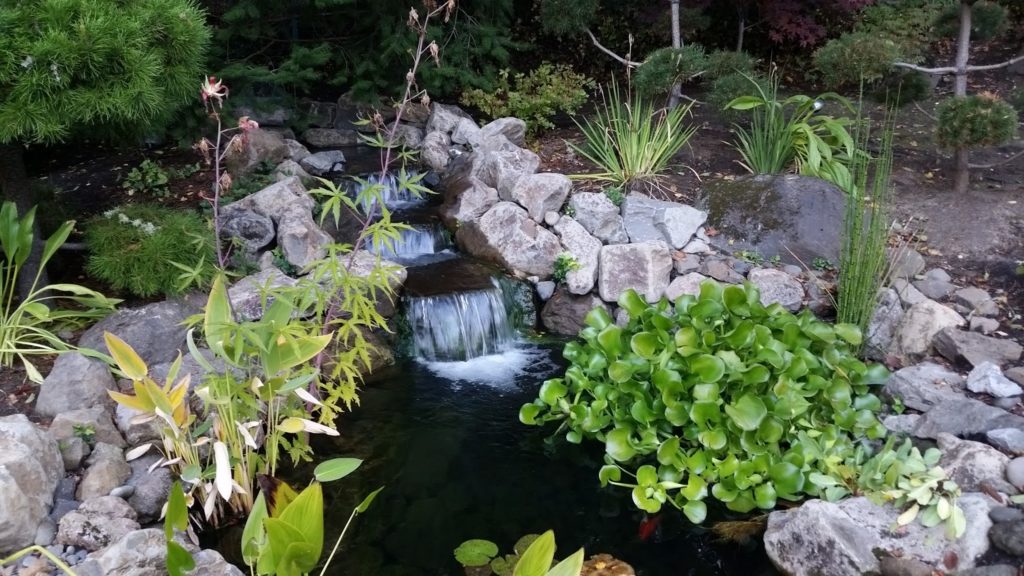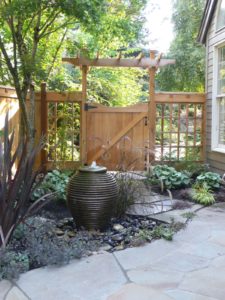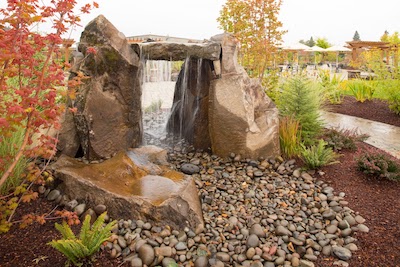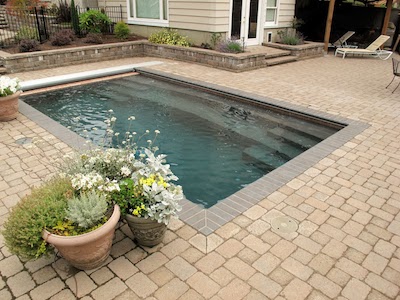Water Features to Fall in Love With
 Landscape design trends come and go, but water features are an ever-popular element that stands the test of time—and with good reason! Water features add a soothing and relaxing ambiance, amp up the luxury factor, and can create that “get-away” feeling right in your own backyard. There are also a plethora of options that will fit pretty much any setting from deck-top or small yard to expansive landscape and everything in between.
Landscape design trends come and go, but water features are an ever-popular element that stands the test of time—and with good reason! Water features add a soothing and relaxing ambiance, amp up the luxury factor, and can create that “get-away” feeling right in your own backyard. There are also a plethora of options that will fit pretty much any setting from deck-top or small yard to expansive landscape and everything in between.
Over the years, we have installed a number of water features in homes throughout the Portland area. Here are some of our favorites.
Fountains
Fountains come in all shapes and sizes and in a wide range of styles from the classic tiered Mediterranean or baroque, to an Asian aesthetic, sleek modern, or more natural cascading stone. Fountains are also almost always standalone features, often a primary focal point in a garden or landscape, with a collection pond or basin from which water is pumped back to the top in a continuous cycle.

Bubbling Fountains
Also known as endless or disappearing fountains, bubble fountains are ideal for small spaces, although size is really only limited by the size of the column or urn. In the most basic setup, water flows up from inside the column or urn, spilling over the sides and onto a bed of stones around the base. Rather than pooling, the water disappears into a basin beneath the stones. The basin, which may range in size from 18-24 inches deep, can also act as an echo chamber amplifying the sound of the splashing water. A pump and filtration system keeps the water cycling through and clean.
Bubblers
In essence, bubblers are the same as disappearing fountains, but without the column or urn. Instead, water simply bubbles up from underground, splashing back onto and disappearing beneath the surrounding surface. Bubblers are also versatile in that they can be large or small, adding visual interest and pleasant sounds, without requiring a lot of space.
Water Walls
Just as the name implies, a water wall is a wall—typically tile, brick, or stone—with water gently cascading down the face. A catch basin, either visible or below the surface, with a pump and filtration system, feeds the water back up to the top in a continual cycle of clean fresh water. Varying the textures of the wall, as well as the size and depth of the catch basin, can affect the sound of the falling water.

Rain Curtains
Relatively simple in concept, rain curtains can add a stunning effect to other water features or as a stand-alone element in the same fashion as a water wall. Rather than flowing down a wall, though, water “rains” out of tiny holes of equal size which are drilled into an upper cross beam and into a catch basin, or echo chamber below. The water is continuously cycled through a pump and filtration system.
Waterfalls
Often installed as part of another water feature like a pond, stream, or swimming pool, waterfalls can also be stand-alone features or “pondless”. Waterfalls can also be designed in a wide range of sizes, configurations, and materials including natural stones, sculpted concrete, or even fiberglass, however, the topography of a site usually dictates size and location. The sounds of a waterfall are dependent on how much water is flowing, as well as the size and number of drops built into the design. In addition to a properly sized pump and filtration system, it is good to also install an auto-fill device to account for evaporation and maintain water levels.

Natural Ponds
The beauty of natural ponds is how seamlessly they can blend into a landscape. While you want to be mindful of size and scale relative to the amount of space you have, ponds can be configured in any number of ways and enhanced with a variety of different features from rocks and boulders to aquatic plants and fish, or even waterfalls. Pond installations typically require excavating a hole and installing an underlayment, or pond liner, along with a filtration system and a pump.
Streams
Creating a natural-looking stream within a landscape takes careful design and planning. Streams also typically require more space than other water features. As with other water features, proper filtration systems and pumps are necessary, as well as an auto-fill device. While they may be more complex to design and install, streams do offer plenty of room for embellishment with other landscape features like plantings, stonework, and structures like footbridges.

Swimming Pools
From simple to elaborate, swimming pools can be pre-fabricated or custom-designed. In either case, they typically require a good deal of space, not only for the pool itself but also for the surrounding patio area and any additional design elements and features (fountains, slides, waterfalls, etc.). The actual footprint of a pool is larger than most homeowners anticipate, but with careful planning and a well-thought-out design, a pool can be configured to fit a wide range of sites.
If you are considering adding a water feature to your own yard, here are a few things to know:
- Most water features are self-contained, but virtually all need a water source due to evaporation. We recommend an autofill or piped water with a manual shut-off on every water feature.
- Any water feature with moving water will need a pump, filter, and power source.
- Maintaining water quality and water levels is essential to keeping the pump functioning properly.
- Lighting can add a stunning effect.
- The safety of pets and children should be considered in the design.
For more tips, check out our previous blog on Proper Planning, Design & Maintenance of water features. And if this is the year you have decided to add a water feature to your landscape, contact us today! Our expert team can help you through the entire process.
